Leadville
What do these photos tell you about how these cities were difference from those cities today?
Leadville In 1875
This is an early photo of Leadville. The buildings were made of logs.
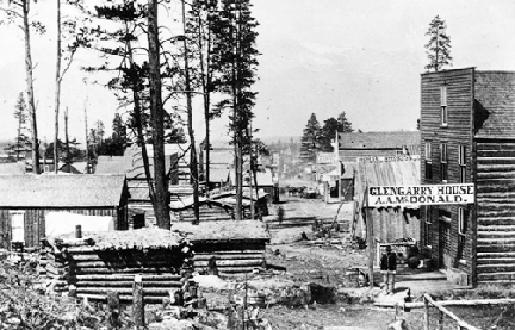
Photo: Denver Public Library, Western History Collection
More About This Topic
The town of Leadville was located in a long valley called California Gulch. Miners had found some gold in the nearby creeks in the 1860s, but not much. Their sluices kept getting clogged with black dirt. This dirt turned out to be a carbonate ore made up of lead and silver. Leadville became a boomtown in 1877, when a smelter was built to recover the silver from the ore. Miners rushed to the Gulch to stake out their claims.
Their Own Words
"The scene unfolded was unlike anything I ever before had seen or conjured in my imagination. The main thorofare was pretty closely and compactly lined with homes on either side, for a distance of two miles, following the contour of the gulch, all of log or rough hewn slab construction, only a few of them two stories in height. Every other door seemed to open upon a saloon, dance hall or gambling den. There were no street lights, but the thousands of coal oil lamps indoors cast fitful flashes of light across the way."
Source: Recollections of Cad Davis, Denver Times, October 10, 1916. Dawson Scrapbooks, Colorado Historical Society.
Drawing Leadville In 1878
This drawing was made in 1878 from the hills above Leadville. This new city was barely a year old.
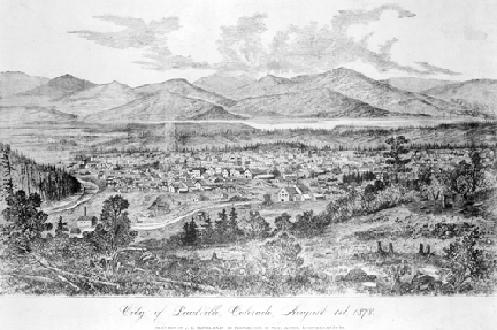
Photo: Denver Public Library, Western History Collection
More About This Topic
Leadville became a major city almost over night. By 1878, Leadville and the area nearby had 120 saloons, 51 groceries, 31 restaurants, 7 hardware stores, and 4 banks.
Their Own Words
"As a glorious camp, rapidly increasing and developing, Leadville is the greatest sensation on record. Its mineral resources are immense, easily developed; communication with the world is laborious and expensive; the climate abominable;…the spirit of the population good and happy. Everybody who wants work gets it, and good pay."
Source: Engineering and Mining Journal (October 5, 1878); Duane A. Smith, Colorado Mining: A Photographic History (Albuquerque, 1977): 27.
Chestnut Street- 1890's
Chestnut Street was one of Leadville's main business streets. This photo of Chestnut Street was taken in the 1890s.
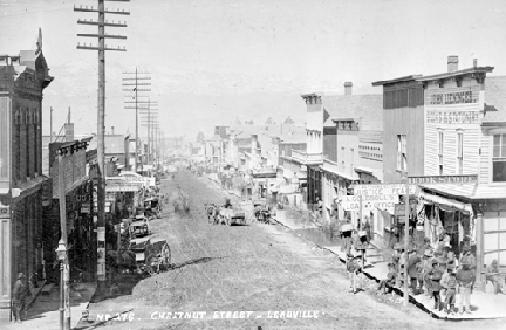
Photo: Denver Public Library, Western History Collection
More About This Topic
The signs on the stores in this photo indicate a bookstore, a drug store, and a loan office, among many other businesses.
Their Own Words
“I have never forgotten my first sight of Leadville [in 1879]. . . . We started up Chestnut Street. We could look up its length, possibly two miles. It was a crawling mass of horses, mules, wagons, and men. It looked impossible to get through, but we made it in about two hours. Leadville then was a town of 25,000 or more people with around a hundred producing mines.”
“The ore was practically all smelted by the six or so smelters in the mining district, so no ore had to be shipped out. But all mining and smelting supplies, all the food eaten, all the people wore and all they drank (this was a considerable item) had to be brought in by the two little narrow gauge railroads to their respective terminals and from there by wagon to town.”
Source: Charles M. Leonard, “Forty Years in Colorado Mining Camps,” Colorado Magazine, 37 (July 1960): 162.
Harrison Avenue- 1900
This photo was taken on Harrison Avenue, another of Leadville's main streets.
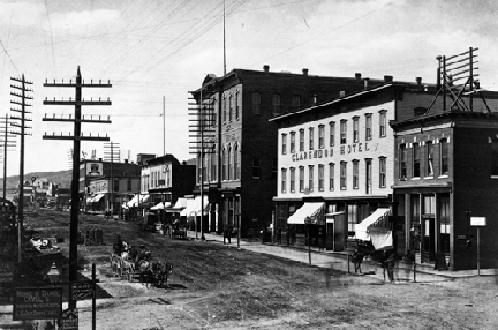
Photo: Denver Public Library, Western History Collection
More About This Topic
Leadville had theaters as well as stores and saloons. The tall building in the center is the Tabor Opera House, which put on plays and musical performances.
Their Own Words
“The Leadville of 1900 to 1906 was a city of some twelve thousand [people], and still dominated, to a very great extent, by the ideals and forces of the earlier mining days of from 1879 to 1900. . . . During his last two years in High School, the writer and two of his sisters had to walk the length of Harrison Avenue, and in doing so passed at least six saloons in five blocks on the west side of the street. As a newsboy, he carried the Leadville Herald Democrat which came off the presses by four or four-thirty in the morning. Frequently the route was completed by 6 a.m. During that time, he left papers at a number of saloons, all of which were open.”
Source: Ivan C. Crawford, “School Days in Leadville,” Colorado Magazine, 36 (July 1959): 227.
The Tabor Opera House
This photo shows the Tabor Opera House. It was the largest building in Leadville when this photo was taken in 1880. The businesses located nearby included the Clarendon Hotel. Hotel guests could use the third floor covered walkway to reach the Opera House.
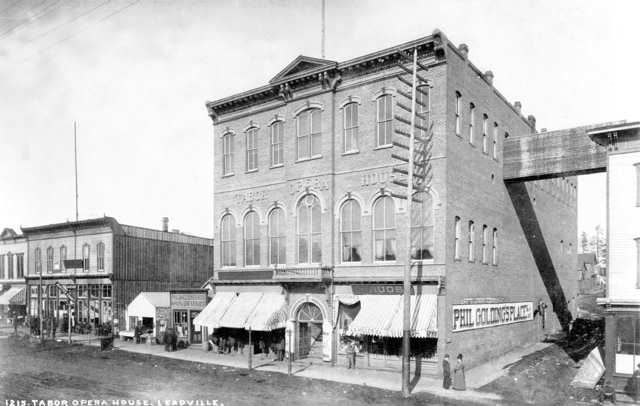
Photo: Denver Public Library, Western History Collection
More About This Topic
The ground floor had merchants' shops. The photo also shows a clothing store, a saloon, and a billiard hall. The Tabor Opera House catered to the wealthier people in Leadville. Less well-to-do people generally frequented other types of entertainment.
Their Own Words
"Leadville at the time was the noisiest place you could imagine. The ore haulers and freighters in the daytime were bad enough, but the dance halls, variety theaters, and saloons at night were worse. There were, as I remember, six large dance halls, about the same number of variety theaters, and innumerable saloons and gambling halls in operation."
Source: Charles M. Leonard, “Forty Years in Colorado Mining Camps,” Colorado Magazine, 37 (July 1960): 164.

